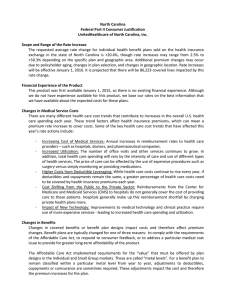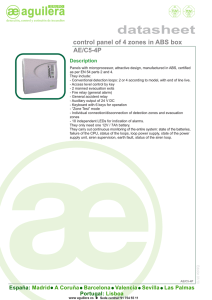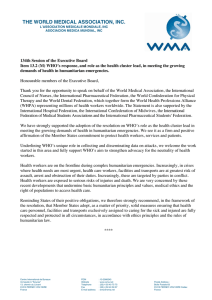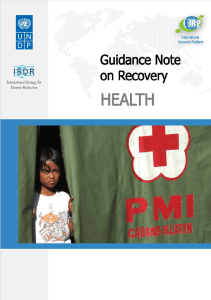Emergency Preparedness, Part 1—February 2002
Anuncio
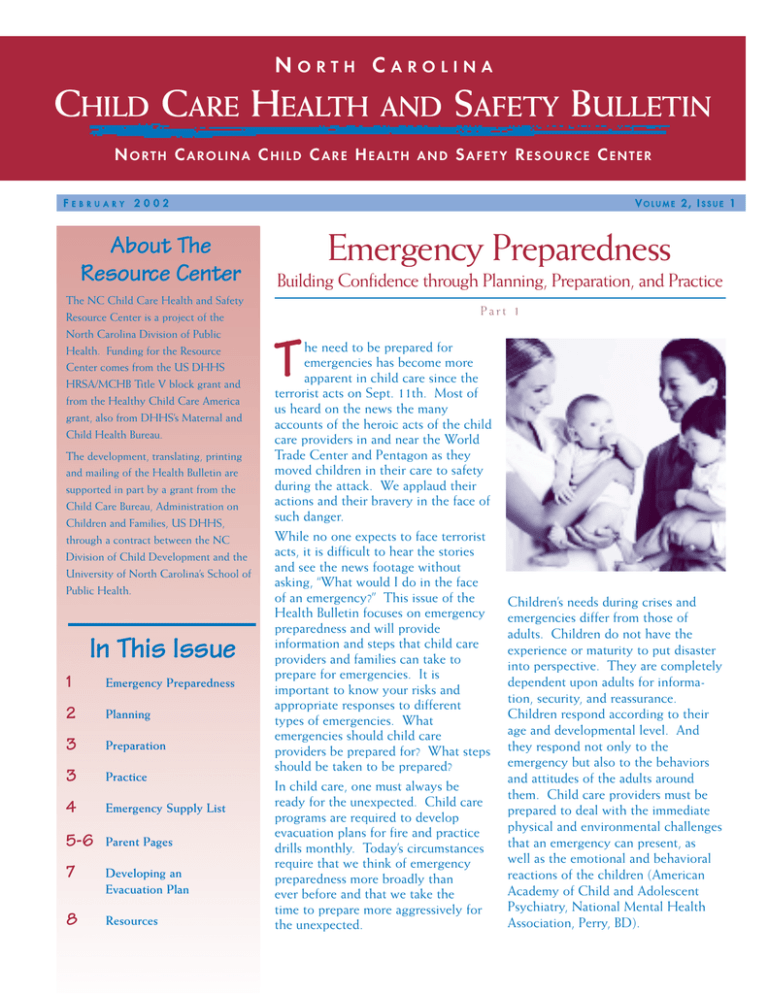
NORTH CAROLINA CHILD CARE HEALTH AND SAFETY BULLETIN N O R T H C A RO L I N A C H I L D C A R E H E A LT H AND S A F E T Y R E S O U RC E C E N T E R FEBRUARY 2002 About The Resource Center The NC Child Care Health and Safety Resource Center is a project of the North Carolina Division of Public Health. Funding for the Resource Center comes from the US DHHS HRSA/MCHB Title V block grant and from the Healthy Child Care America grant, also from DHHS’s Maternal and Child Health Bureau. The development, translating, printing and mailing of the Health Bulletin are supported in part by a grant from the Child Care Bureau, Administration on Children and Families, US DHHS, through a contract between the NC Division of Child Development and the University of North Carolina’s School of Public Health. In This Issue 1 Emergency Preparedness 2 Planning 3 Preparation 3 Practice 4 Emergency Supply List 5-6 Parent Pages 7 Developing an Evacuation Plan 8 Resources VOLUME 2, I SSUE 1 Emergency Preparedness Building Confidence through Planning, Preparation, and Practice Part 1 T he need to be prepared for emergencies has become more apparent in child care since the terrorist acts on Sept. 11th. Most of us heard on the news the many accounts of the heroic acts of the child care providers in and near the World Trade Center and Pentagon as they moved children in their care to safety during the attack. We applaud their actions and their bravery in the face of such danger. While no one expects to face terrorist acts, it is difficult to hear the stories and see the news footage without asking, “What would I do in the face of an emergency?” This issue of the Health Bulletin focuses on emergency preparedness and will provide information and steps that child care providers and families can take to prepare for emergencies. It is important to know your risks and appropriate responses to different types of emergencies. What emergencies should child care providers be prepared for? What steps should be taken to be prepared? In child care, one must always be ready for the unexpected. Child care programs are required to develop evacuation plans for fire and practice drills monthly. Today’s circumstances require that we think of emergency preparedness more broadly than ever before and that we take the time to prepare more aggressively for the unexpected. Children’s needs during crises and emergencies differ from those of adults. Children do not have the experience or maturity to put disaster into perspective. They are completely dependent upon adults for information, security, and reassurance. Children respond according to their age and developmental level. And they respond not only to the emergency but also to the behaviors and attitudes of the adults around them. Child care providers must be prepared to deal with the immediate physical and environmental challenges that an emergency can present, as well as the emotional and behavioral reactions of the children (American Academy of Child and Adolescent Psychiatry, National Mental Health Association, Perry, BD). 1 P The “Three P’s” for Emergency Preparedness: Planning, Preparation and Practice Planning To plan ahead, the Division of Child Development suggests that child care programs build on the required emergency procedures to develop a comprehensive emergency plan. It is important to know your risks (Emergency Preparedness Tips for Child Care Providers, NC Division of Child Development, Nov. 2001). There are many types of emergencies and disasters some of which you need to be prepared for based on your location and surroundings. The Federal Emergency Management Agency (FEMA) recommends contacting the local Red Cross chapter or emergency management office and asking what types of disasters are most likely to happen (Preparedness, Federal Emergency Management Agency, http://www.fema.gov/pte/ displan.htm). ■ National risk assessment: After Sept. 11th, the risk of terrorist acts, biological warfare, or chemical warfare have received much attention. It is important to be informed of national issues that could impact your area. ■ State risk assessment: • North Carolina has not been the target of any terrorist attacks to date, and the risk of local attacks is deemed to be low. However, our state is on a heightened state of awareness along with the rest of the nation and taking the necessary measures to be prepared in case North Carolina does become a target. In response to the terrorist attacks, Gov. Easley has established an Anti-terrorist Task Force with subcommittees working on threat assessment, emergency response, training, and public information. Information is retrievable from the website www.ncgov.com (go to Safety and Security), or, if you have specific concerns or questions, call the North Carolina Child Care Health and Safety Resource Center at 1-800-246-6731. • Natural disasters: In North Carolina, weather related emergencies may occur suddenly and often come in the form of severe thunderstorms, winter storms (snow and ice), tornadoes, hurricanes, and flooding. Consider how your program will be alerted to threatening weather conditions. In child care, caregivers are urged to turn televisions/radios off and to interact with the children. Is someone in your program available to stay abreast of weather 2 • HEALTH AND SAFETY BULLETIN • FEBRUARY 2002 conditions? Has your program been given a NOAA weather alert radio as a part of a recent initiative by local and state emergency management officials? If not, consider purchasing a weather alert radio that sends alert tones in the event of severe weather conditions. What are your community’s warning signals? Do you need to assign the task of alerting your program to someone in your program or work with a local agency to develop a community wide alert system for caregivers? ■ Local area risk assessment: • What risks are present in the surrounding area? Is the program located near a chemical plant, nuclear power plant, road often traveled by transfer trucks, or airport? Consider contacting your local emergency management office to learn about the risks associated with these and other factors. Consider contacting a law enforcement professional to perform a security sweep of the area to identify vulnerabilities due to the location of the program — proximity to a bar, a forest, a “crack house,” a hospital (with fast-moving ambulances), a jail or other institution, or a major highway (Copeland, 1/96). ■ Program risk assessment: • Address risks in the immediate indoor and outdoor environment that could cause an emergency (fire hazards, maintenance issues, storage issues). With a clear idea of your risk, make sure your program has policies and procedures in place to address the risks. • Develop a comprehensive emergency plan and program policies for emergency response. 2 Preparation • Learn which responses are required for different types of emergencies (evacuation, sheltering in place [i.e., staying/going inside, finding a “safe place”], relocation). Identify “safe places” inside your building; for example in a tornado or severe thunderstorm, a “safe place” would be a basement or ground-floor room with no windows. Develop plans for each type of response. • Make arrangements for transportation of all children in case relocation is needed. • Plan how you will communicate with parents, local authorities, and the Division of Child Development. • Plan what you can say to children to reduce their fears, comfort them, and increase safety. • Prepare parents — review emergency plans with them and how you will communicate with them if an emergency occurs. • Get informed consents from parents to take emergency action, such as to provide/seek emergency medical care. • Have a portable set of emergency contact information (parent contact information and back-up contact) with you at all times — make copies and put them near the building exit, in vehicles, etc. Keep information up-to date. • Have up-to-date emergency medical information for each child and each adult employed (doctor, insurance, special needs information such as allergies or diabetes). • Identify and make arrangements with two places (e.g., another child care facility, school, or recreational facility) about a mile away where you can take children if relocation is necessary. • Prepare staff — train staff on your emergency plan at least once a year. As required, stay current on CPR, First Aid Training, and hold practice fire drills monthly. Carry out other types of drills (e.g., for tornadoes) on a periodic basis. Preparation is needed to carry out your comprehensive emergency plan. • Put daily attendance sheet by the door so it can be taken outside if evacuation is necessary. • Provide blankets, water, other weather related supplies outside the building and/or in vehicles in the event that evacuation is needed during extreme weather conditions. • Periodically train staff on how to use fire extinguishers — you can contact your local fire department for assistance. Each month, test smoke alarms and fire extinguishers. • Put a map of the area in your vehicle or in an outdoor location. 3 • If you are caring for a child with special health care needs such as asthma, diabetes, or limited mobility, coordinate with the child’s parents, doctors, and other medical professionals to develop an individual emergency care plan. Practice “As the ground shook, teachers grabbed each child’s emergency records, took babies in their arms, and following a drill they practiced every month, led the children outside . . .” (Shellenbarger, Sue. Sept. 26, 2001). Practice is important for children, for caregivers, and for parents. Practice builds confidence and prepares everyone to respond to an emergency knowledgeably and competently. As child care providers affected by the terror attacks of 9/11 learned, practice helped them know what to do during a crisis and relocate safely. • As required, practice fire drills monthly and document. • Have staff identify at least two ways out of each room and practice evacuation through alternate exits. • Practice (seasonally) “sheltering in place” drills when outdoors and in different locations indoors, locating children and staff to a designated safe place indoors. • Review relocation drill at least annually and practice with staff during staff meetings. Review relocation plan with parents — make sure new staff and parents are informed. • Review individual emergency care plans for children/adults with special health care needs quarterly to keep information current. • Depending upon the age of the children, review plans verbally and in a non-threatening tone that helps them feel protected and safe. • Replace stored water and stored food every six months. • Change stored batteries at least once a year. • Loud alarms or buzzers can sometimes be frightening to children. Consider using an alert system in practice that does not frighten children but one they can identify as an alarm. Be sure this is what is used in a real emergency. • Use a checklist for your practice to help staff learn to take necessary actions automatically (taking attendance log, retrieving emergency contact and medical information, comforting dialogue with children, time it takes to complete emergency action). Continued on Page 7 FEBRUARY 2002 • HEALTH AND SAFETY BULLETIN • 3 1-800-246-6731 North Carolina Child Care Health & Safety Resource Center Emergency Supplies Kit for Child Care Programs (should be portable in case of evacuation) Providing Training, Consultation & Resources for North Carolina‘s Child Care Community H O L D T H E D AT E ! • List of emergency phone numbers March 12 and 13, 2002 • (As available) cell phone, calling card, change for pay phones, “walkie talkies” Healthy Child Care North Carolina Conference North Carolina Infant and Toddler Symposium • Water — backup supply of what you typically use in a day (Note: boiled water is not good for infants.) William and Ida Friday Center 100 Friday Center Drive Chapel Hill • Non-perishable food; manual can opener • First aid kit, blankets Contact the North Carolina Child Care Health and Safety Resource Center at 1-800-246-6731 for information. • Radio, flashlights, extra batteries • Handwashing solution that does not require running water • Extra clothing/shoes • Diapers, baby food/formula, other special items for infants and toddlers • Other items for safety and comfort. If evacuating/relocating, remember child and adult records, attendance sheets. Reference: February is American Heart Month Black History Month National Children’s Dental Health Month AMD/Low Vision Awareness Month Wise Health Consumer Month February 6 is National Girls and Women in Sports Day February 10 – 16 is National Child Passenger Safety Awareness Week NC Division of Child Development (Nov. 2001). Emergency Preparedness Tips for Child Care Providers, retrieved 1/8/02 from www.dhhs.state.nc.us/dcd/provider.htm. 4 • HEALTH AND SAFETY BULLETIN • FEBRUARY 2002 g e s Pa The terrorist acts of September 11 have made many families think about how well they are prepared to handle emergencies. North Carolina has experienced many natural disasters such as flooding, severe thunderstorms, ice storms, hurricanes, and tornadoes. The best way to keep your family safe is to have a plan for dealing with emergencies. Many parents also have concerns about what to tell their children when emergencies occur. The following information was developed to help families prepare for emergencies. Family Emergency Plan Information Some Suggested Items for Emergency Supplies Kit*: ❐ Water ❐ Food ❐ Medicine ❐ Battery operated flashlight ❐ Battery operated radio ❐ Extra batteries ❐ Blankets or sleeping bags ❐ Extra clothes and shoes ❐ Diapers and wipes ❐ First aid kit (*From “Family Disaster Plan,” developed by the Federal Emergency Management Agency and the American Red Cross. See full list at www.fema.gov/pte/prep.htm) In addition to the above supplies, the American Academy of Pediatrics recommends preparing a “Get Ready Kit” for children. Suggested items to include are: ❐ Favorite books ❐ Crayons, paper ❐ Favorite small toys ❐ A favorite stuffed animal ❐ Favorite blanket and/or pillow ❐ Pictures of the family and/or pets ❐ Know the types of disasters most likely to occur in the area where you live and develop a plan before the disaster occurs. Call your local emergency management or Red Cross office for assistance. ❐ Identify “safe places” within your home. ❐ If you live in a hurricane-prone area, know where the nearest shelter is located if you must leave your home. In other areas not prone to hurricanes, it will be important to monitor a battery-operated radio or TV for announcements of designated shelters during a disaster. ❐ Practice family fire drills and other emergency drills regularly. ❐ Identify two different ways to exit from each room where you live and practice using both of them. ❐ Identify a meeting place just outside the home and another outside the neighborhood in case the area right outside the home is not safe. ❐ Designate a family member out of the calling area as a point person for everyone in the family to call in an emergency. (In many emergencies, local phone circuits are busy, so it’s sometimes easier to reach someone out of state or at least out of town.) ❐ Teach children how and when to call 911. ❐ Teach children what smoke detectors, fire alarms, and community warning systems sound like and what to do when they hear them. ❐ Prepare emergency supplies that can be easily transported in a back pack or duffle bag. 1.800.246.6731 r e n Pa t ❐ Any item that makes the child feel secure FEBRUARY 2002 • HEALTH AND SAFETY BULLETIN • 5 Resources Books Reading books with your children and talking about what happened is one healthy way to deal with some of the feelings associated with disasters. A child’s favorite book can be very comforting during stressful times. Books recommended in the December 2001 Issue of Child Magazine include: • Brown, Laurie Krasny and Brown, Marc Tolon, When Dinosaurs Die, Little Brown, NY, NY, 1996. • Bang, Molly Garrett, When Sophie Gets Angry – Really, Really Angry, Scholastic, NY, NY, 1999. The American Psychological Association also recommends the following books: • Bunting, Eve, Smoky Night, Harcourt, Orlando, FL, 1999. • Holmes, Margaret, A Terrible Thing Happened. American Psychological Association, Magination Press, Washington, DC, 2001. • Birdseye, Debbie Holsclaw and Birdseye, Tom, What I Believe: Kids Talk About Faith, Holiday House, NY, NY, 1996. • Cain, Barbara, Double Dip Feelings: Stories to Help Children Understand Emotions, 2nd edition, American Psychological Association, Magination Press, Washington, DC, 2001. • Pellegrino, Margorie White, I Don’t Have an Uncle Phil Anymore, American Psychological Association, Magination Press, Washington, DC, August 1998. • Mills, Joyce C., Ph. D., Gentle Willow: A Story for Children About Dying, American Psychological Association, Magination Press, Washington, DC, September 1993. • Leghorn, Lindsay, Proud of Our Feelings, American Psychological Association, Magination Press, Washington, DC, December 1995. Bookstores in the Raleigh/Durham area also recommend these books which families have told them were helpful: FREE BOOKS FOR CHILDREN from the Federal Emergency Management Association (FEMA): Herman P.I.C. and the Hunt for a Disaster Proof Shell, written by Holly Harrington, can be ordered by calling 1-800-480-2520, or can be downloaded by computer at www.fema.gov/kids/herman. Other Free Materials for Families Call FEMA at 1-800-480-2520 • Coloring Book: Disaster Preparedness Ask for # 8-1123 • Video: “Prepare to Survive” Ask for # 9-1074 • Brochure: Family Disaster Supply Kit Ask for # L-189 • Hurd, Edith Thatcher, The Black Dog Who Went to the Woods, HarperCollins Publishers, Inc.,NY, NY, March 1980. • Doorknob Hanger: Fire Safety Ask for # 5-0200 • Simon, Norma, The Saddest Time, Econo-Clad Books, Minneapolis, MN, October 1999. • Brochure: “Tornadoes…Nature’s Most Violent Storms” Ask for # 8-1145 • Aliki, The Two of Them, Morrow, William & Company, NY, NY, September 1987. • Miles, Miska, Annie and the Old One, Little, Brown, and Company, NY, NY, February 1985. • Bauer, Marion, On My Honor, Bantam Books, NY, NY, July 1987. • Steig, William, Abel’s Island, Farrar, Straus, and Giroux, NY, NY, July 1985. • Viorst, Judith, The Tenth Good Thing About Barney, Simon and Schuster, NY, NY, August 1971. 6 • HEALTH AND SAFETY BULLETIN • FEBRUARY 2002 • Brochure: “Safety Tips for Hurricanes” Ask for # 0-17L105 Continued from Page 3 Developing an Evacuation Plan The plan should be easy to understand. A diagram of evacuation procedures is easiest to follow in an emergency. The plan should be clear enough for a visitor to the facility to follow the instructions. Mapping the facility: ❐ Label every exit, including doors, windows and hallways. ❐ In every room, label the primary exit (usually a door or hallway) and a secondary exit (usually a window) in case the primary exit is blocked by smoke or flame. ❐ Label the main valves of the gas, electricity and electrical circuits and water lines. ❐ Establish a safe meeting place so everyone can be accounted for. ❐ Draw floor plan layouts that show two alternate exit routes. Down to Safe Place ❐ Label severe weather “safe places” in the building. Room 1 Room 2 Room 3 ARE HERE EX I T EX I T YOU Room 4 Window EX I T References: American Academy of Child and Adolescent Psychiatry (May 2000). Helping Children After a Disaster, retrieved 1/8/02 from www.aacap.org/publications/factsfam/disaster.htm. American Academy of Pediatrics, Committee on Pediatric Emergency Medicine (October 1999). Emergency Preparedness for Children with Special Health Care Needs, Pediatrics, 104:4. American Public Health Association, American Academy of Pediatrics. (2002). Caring for Our Children: National Health and Safety Performance Standards: Guidelines for Out-of-Home Child Care Programs, 2d Ed. Washington, DC: American Public Health Association, Elk Grove Village, IL, American Academy of Pediatrics. American Red Cross (2001). Disaster Services: Be Prepared, retrieved 1/8/02 from www.redcross.org/services/disaster/beprepared. Brach K. The three “P’s“ of emergency preparedness. Presentation to the National Training Institute for Child Care Health Consultants; 2001 Mar 16-18; Chapel Hill, NC. Copeland, Margaret Leitch (Jan. 1996). Code Blue! Establishing a Child Care Emergency Plan, Child Care Information Exchange, 17 - 22. Federal Emergency Management Agency. Preparedness, retrieved 1/8/02 from www.fema.gov/pte/displan,htm. National Mental Health Association (Sept.17, 2001). Helping Children Handle Disaster-Related Anxiety, retrieved 1/8/02 from http://www.nmha.org/reassurance/children.cfm. N. C. Cooperative Extension (July 1994). Preparing Your Family for Disaster, retrieved 1/8/02 from www.ces.ncsu.edu/disaster/handbook/disaster2.html. NC Division of Child Development (Nov. 2001). Emergency Preparedness Tips for Child Care Providers, retrieved 1/8/02 from www.dhhs.state.nc.us/dcd/provider.htm. Perry, B. D. (Sept. 1999). Stress, Trauma and Post-traumatic Stress Disorders in Children. Interdisciplinary Education Series, 2:5. Pre-final Draft retrieved 1/8/02, http://www.childtrauma.org/ptsd_interdisc.htm. Shellenbarger, Sue. Quality Child Care Protected Kids Caught in Terror Attacks. Wall Street Journal, September 26, 2001. FEBRUARY 2002 • HEALTH AND SAFETY BULLETIN • 7 Additional Resources and Links Recommended by the N. C. Division of Child Development HEALTH BULLETIN VOL. 2 ISSUE 1 EDITOR: Janet McGinnis CONTRIBUTORS: • American Academy of Pediatrics www.aap.org/advocacy/releases/disastercomm.htm. Debbie Garrett, Jonathan Kotch, Neelam Nagle, Mary Pender, Jacqueline Quirk, Jeannie Reardon, SPECIAL THANKS • American Red Cross www.redcross.org. (Note: there is a search function that allows you to locate your local Red Cross chapter). TO: Anne Scharff, Division of Child Development Steve Marks, Assistant Coordinator, GreensboroGuilford County Emergency Management • North Carolina Division of Emergency Management (see “Local EM Links” or look in This publication is produced by the North Carolina Child Care Health and Safety Resource Center and distributed to licensed child care facilities, CCR&R agencies, Smart Smart partnerships, DCD child care consultants, and child care health consultants throughout North Carolina. the blue pages in your telephone book to find your local Emergency Management Office) www.dem.dcc.state.nc.us/. You may download a copy of this publication from our website at: www.healthychildcarenc.org • National Association for the Education of Young Children (NAEYC) www.naeyc.org/coping_with_disaster.htm. • North Carolina State University Cooperative Extension www.ces.ncsu.edu/depts/fcs/humandev/disas3html. Articles may be reprinted without permission if credit is given to the bulletin and the material is not reproduced for commercial purposes. FOR MORE INFORMATION • Purdue University Extension www.ces.purdue.edu/terrorism/children/terrorism.html or if you would like to send comments WRITE: Tell us what you think! Please call us at the Resource Center and let us know how you liked this issue. NC Child Care Health & Safety Resource Center 1100 Wake Forest Road, Suite 100 Raleigh, NC 27604 OR CALL: 1-800-246-6731 We have included a new section, Parent Pages, so you can make copies and distribute to parents of children you serve. We want to know if you find this useful, how you use the newsletter and we would like to hear suggestions for topics you want to know more about. Thanks! 1-800-246-6731. 10,000 copies of this document were printed at a cost of $.46 per copy 8 • HEALTH AND SAFETY BULLETIN • FEBRUARY 2002 NC Child Care Health & Safety Resource Center 1100 Wake Forest Road, Suite 100 Raleigh, NC 27604 Nonprofit Org US Postage PAID Chapel Hill, NC Permit No. 177 POSTMASTER: Please deliver as soon as possible – time dated material enclosed
